,
The year 2008 marks Tapissary’s 31st anniversary. To celebrate, I’ve been making adjustments to the grammar. The journal is my practice sheet where I merge linguistic invention with my daily experiences. Formulas such as [< >] +/\ are indications of my cyclic grammar.
L'année 2008 correspond au 31ème anniversaire de ma langue inventée de Tapissary. Pour le fêter, mon cadeau c'est le plaisir d'expérimenter avec des rajustements de la grammaire. Ici, dans les pages du journal, je fonds l'invention linguistique avec mes expériences quotidiennes. Mes formules telles que [< >] +/\, sont les indicateurs de la grammaire des cycles.
.
.
tapissed entries

,
10 05 2008
Campaigne Button in Tapissary

Can you guess who my candidate is? Here's a clue, his name in Tapissary's syllabary has 5 letters... bë + rak + o + ba + më.
I found the film above on you tube
. . .
10 03 2008
Palin and Biden debate
Has President George Bush set a precedent in American politics? It would seem that Sarah Palin is as much the spoiled little girl, as George Bush is the spoiled little boy. How do you explain to them that the globe is not a toy?
I was struck by Governor Sarah Palin's insincerity in the vice presidential debates last night with Senator Joseph Biden. Neither was she a match for Biden's intelligence. In the free online version of the New York Times, I found a few remarks in response to the article about the debate. It clarifies Palin's serious faults. Here are some thoughtful and/or humorous comments among many. I chose to translate the first one into Tapissary. [See below]
Issue? What issue? Baby, Vote for me! Wink, Wink...
— Heather, Chapel Hill, NC
Watching the debate I kept wondering what transgression Joe Biden had commited requiring him to debate Barbie for 90 minutes. It seems there really are no standards left in this country if anyone thinks Sarah Palin should be anywhere near the White House except for an Easter Egg hunt on the lawn with her growing family.
— LISA S, Wynnewood PA
The very last thing this country needs right now is a folksy gal who speaks in spin. With the country "on the edge of the precipice" right now, it is appalling that all the Republican vice presidential candidate needed to do tonight to exceed expectations was to string together words in full sentences, instead of the rambling incoherence she showed in the Katy Couric interviews. To consider her performance in the debate as a success is evidence of what is wrong with America today.
— AnneCW, Chicago
Palin was so mired in her script, she found it impossible to react appropriately to the one emotionally real part of the debate: Biden's discussion of his family. Her rote response was cold and pinched. She just seems like a robot to me.
— Eric, Chicago, IL
. . .

[Read the text above from left to right]
English: "Issue? What issue? Baby, Vote for me! Wink, Wink..."
Tapissed transliteration: "Issue? What non (is)'nt not issue? Baby, your'st vote casts for me! Wink, wink..."
(NOTE: The triple negative indicates the nullic key, while the voting phrase is in the second pitch, i.e. the scionative, which emphasizes an interaction... wink, wink.)
. . .
9 28 2008
New Terminology
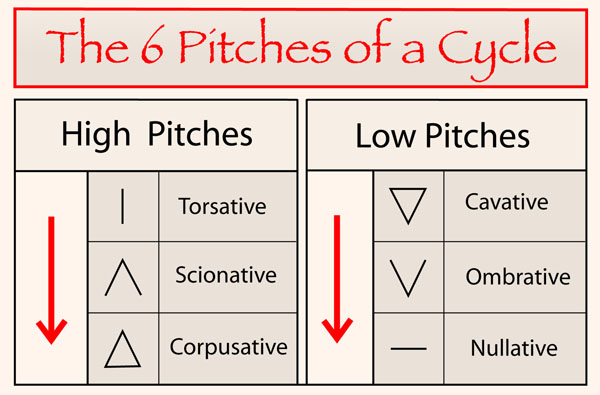
I've made some changes in terminology. I often refer to the regions within a cycle as 'coordinates', 'stations', 'longitudes', or 'degrees'. They all mean the same thing. Recently, I've chosen the term 'pitch' because it conveys the idea of being part of a cycle, and for convenience sake, it is only one syllable long. It just takes too long to keep repeating 'coordinate' or 'longitude'. 'Stations' and 'degrees' are too clinical. But 'pitch' relates to music or sound, and I think it's a warmer concept.
The pitches themselves, of which there are six, have been undergoing name changes as well. Their traditional names were:
1. (first coordinate): Torso
2. (second coordinate): Limbs
3. (third coordinate): Pose
4. (fourth coordinate): Cavity
5. (fifth coordinate): Shadow
6. (sixth coordinate): Void
. . .
You may be able to tell how the new names are derived from the older ones:
Torso > Torsative (TOR-sa-tiv)
Limbs > Scionative (a scion is a branch) (sigh-ON-a-tiv)
Pose > Corpusative (from corpus: body) (corp-YOU-za-tiv)
Cavity > Cavative (CA-va-tiv)
Shadow > Ombrative (from Latin meaning shadow) (OM-bra-tiv)
Void > Nullative (from null) (NUL-a-tiv)
I apply names to pitches because it is misleading to describe the progressions of pitches within a given text by numbers. If I say the sentence in coordinate 2 is followed by a sentence in coordinate 4, then the idea that pitches are related to numbers might be erroneously mistaken. While it's true that each pitch builds upon the previous, the attributes are not numeric, but rather possess individual qualities. When taking the same example of coordinates 2 and 4, it might come across less formulaic were the numbers replaced with the terms scionative and cavative.
. . .
9 23 2008
An Old Draft as a Test for My New Scanner
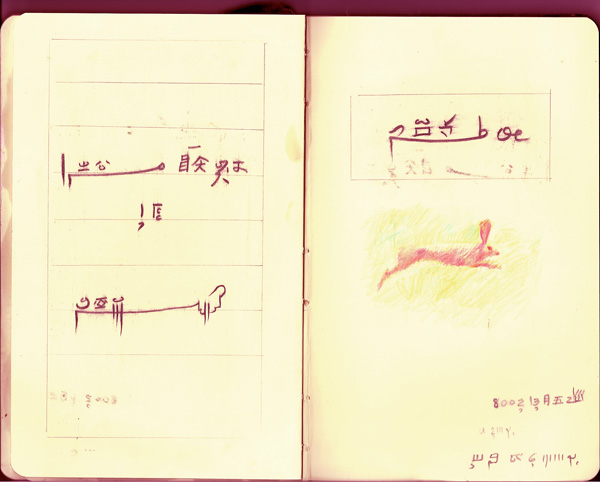
Today I got a scanner. This is going to make my project much easier. Now when I do drawings and pencil texts, the sheets can be scanned instead of photographed. Not that anything is wrong with the camera, but trying to control the lighting is much harder, and I never get fine detail. The scanner, on the other hand, picks up the subtleties of the pencil mark. I will continue to photograph my texts when they are written on a dry erase board, because the board itself is too large to fit over the scanner.
The 2 pages here are from my original trial of Alice in Wonderland, at a time when I had planned to do a translation of the original. Now, of course, I'm writing my own version of the story, so the previous works will not be included. This is therefore a discarded draft. In some places in this booklet of drafts, ghost texts from the other side of the page are detectible, because I was experimenting with melting bee's wax into the page for a translucent effect. Indeed, the text just above the rabbit drawing records this. It says: Experiment with bee's wax.
. . .
9 17 2008
Iambic Pentameter and Tinderbox
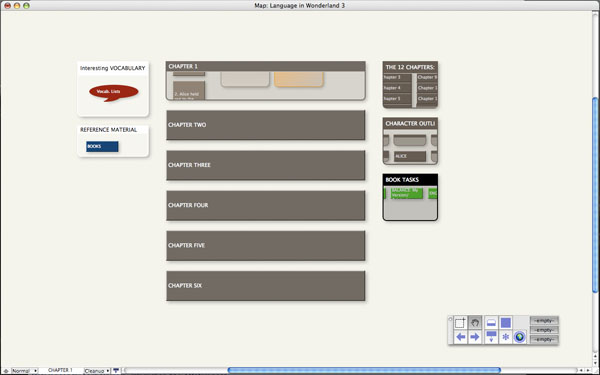
I haven't read any more lately about Tinderbox software, because so far, the very elementary introduction has been sufficient for my purposes. No doubt as my book grows, there will be other features I will need to study. Even though Chapter One of my Alice in W version is only in its very beginning stages, I'm starting to list other chapters as well, since I tend to work up my story pattern in many areas at once. With Tinderbox, even if I totally change the structure of the chapters in the future, it would be easy to rearrange things. I really like the way flexibility is welcome in this program.
Because Lewis Carroll wrote many poems into Alice in W, I want my version to coincide with that tendency in mind. To that end, I'm anxious to learn the design of traditional poetry. I've just begun reading a book by Timothy Steele on Verse. It's called "all the fun's in how you say a thing". Two days ago, I didn't know what iambic pentameter meant, much less how to pronounce it (iAmbic penTAmeter). The concept is simple: iambic means that you accent every other syllable, where the second syllable of each pair is accented. Ex: how DID / you KNOW / paTRICE / would COME / so LATE. In that example, you might notice that there are 5 pair. That's what pentameter means, that there are 5 pair of syllables on each line. The sentence itself is therefore 10 syllables long. This formula has been one of the most commonly used for Western poetry since before the time of Shakespeare.
With that said, here's a little about my activity so far, which I will explain via iambic pentameter just for the fun of it:
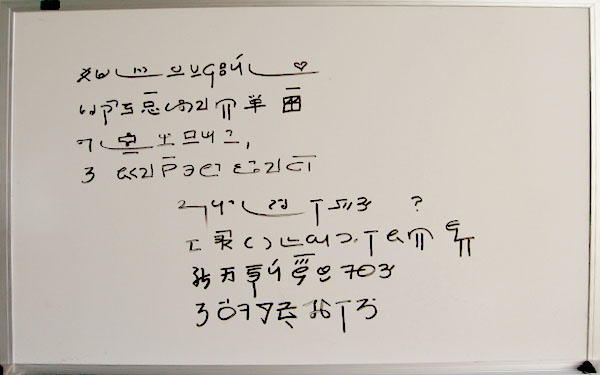
. . .
Right now I have new software that I love,
Which keeps my thoughts arranged in simple charts.
Before I used to waste a lot of time,
With scribbled words and other jumbled parts.
So why should I decide to poetize?
It takes much longer than to write in prose.
Perhaps the fact that glyphs can sympathize,
With cyclic* grammar's challenge to compose.
. . .
*In case you haven't seen other parts of my site, cyclic grammar refers to a system I devised for Tapissary that deals with the movement and evolution of a given sentence. It's much easier than it sounds, but like poetry, it requires careful consideration to how you wish to convey your ideas.
. . .
9 14 2008
Experimenting with software to take notes
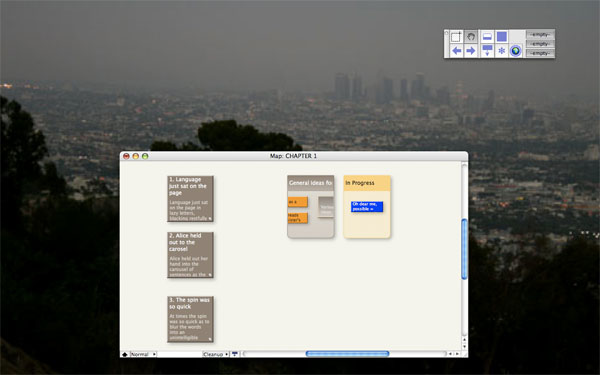
Yesterday, I started using my new software for organizing notes. It's called Tinderbox. There's a lot I have to read in the owner's manual before becoming proficient with it, but the basics are already giving me a much better system of organizing ideas. I've decided instead of translating Alice in Wonderland into Tapissary, that I would write my own version (also in Tapissary). This will require keeping notes handy and easy to find. I got the software through Eastgate Systems (eastgate.com). Even at these beginning stages, I'm having incredible fun playing around with the text windows, and assigning colors to them while experimenting with other interesting features. I've been using it for less than 24 hours as I write this, so as my skills progress, I will be able to make additional posts.
The above image is taken off my desktop. I placed the Timberbox work area into the center of the screen, then dragged the toolbox to the upper right. It's easy to expand or decrease the work area in Timberbox. Here, the size is small. You can make the print very large, and it's very easy to add new text. It allows for pictures and movies also, though I won't be experimenting with that for a while.
. . .
9 6 2008
Coming along with Alice in Wonderland
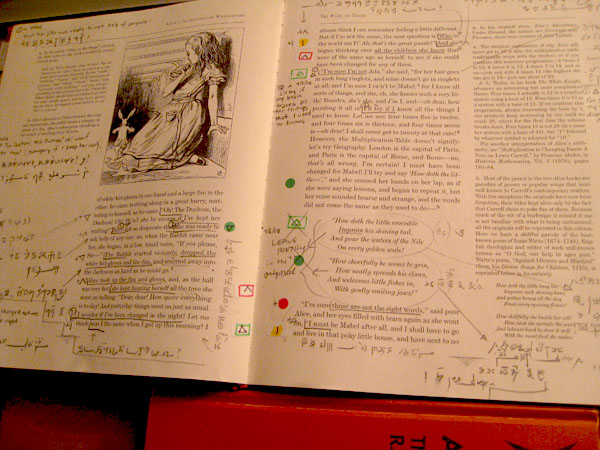
My Alice in Wonderland project is coming along, though I know it's regretful to scribble onto the pages of a book. But there are many decisions to consider before going full swing into the 'translation', and I need a visual map to see this. Even though this is just the beginning of a work which will fluctuate noticeably in the coming months, I thought I'd occasionally post my progress. For the time being, I am assembling my ideas of what kind of perspective I will take on Alice, what style I will use for the illustrations, what ratio will be present of Tapissary to English, and how much vocabulary and grammar should be introduced in each chapter. Further down the line, the format (book or ebook) will be determined. The page above is an example of the notes I'm taking, and the grammar I'm plotting. As different perspectives surface, I make alterations, so the pages become riddled with layers of possibilities. There is another notebook to accompany the main text, where I write variant chapters, keep tabs on vocabulary and grammar, and lists of brainstorming ideas.
. . .
8 8 8
Eights
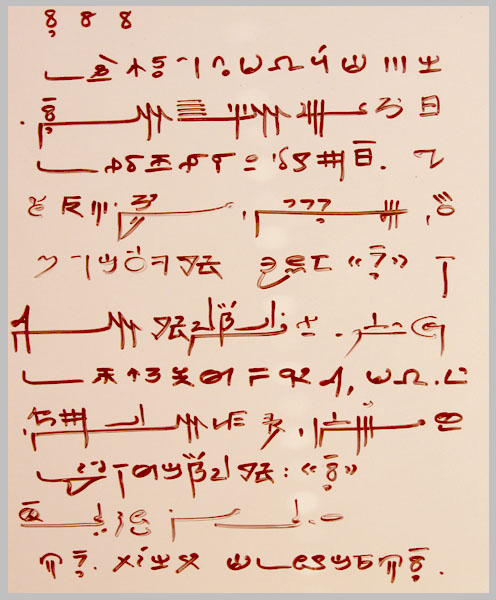
I didn't realize until late this morning that today is a date composed of a row of eights. I always like to do something special on interesting numerical dates. Last year, on 7 7 07, I'd made a large adjustment to the cyclic grammar, and called it "Sevens" to commemorate that day. As for the simplified grammar of Tapissary, I came up with the name Base Coat Tapissary, this morning. Then later in the day, taking account of the numerical coincidence, I decided to name the simplified grammar: "Eights".
Recently, I've been writing my entries in Sevens. But for a change, today I'm writing the text in Eights.
. . .
,
,
.[][][][][][][][][][][][][][][][][][][][][][][][]
.


